
"Anonymous Implant(s)" is a dynamic performative project by Kosuke Kawahara as a part of his solo exhibition Exotic Star. It includes eight sheets originally meant to protect his studio surfaces. The project unfolds in three ways: on-site drawing in the gallery, wild posting in the streets, and direct distribution of prints to gallery visitors. The title of the project suggests a subtle integration of Kawahara's work into various spaces, aiming to bridge different environments and offer an immersive experience beyond traditional exhibition. While assisting with Kawahara’s solo show at RAINRAIN and witnessing him carry out the project on-site at the gallery, I intend to record my experiences from the past weeks, capturing the project's growth and the intimate connection between Kawahara’s art, the space, and the viewers.
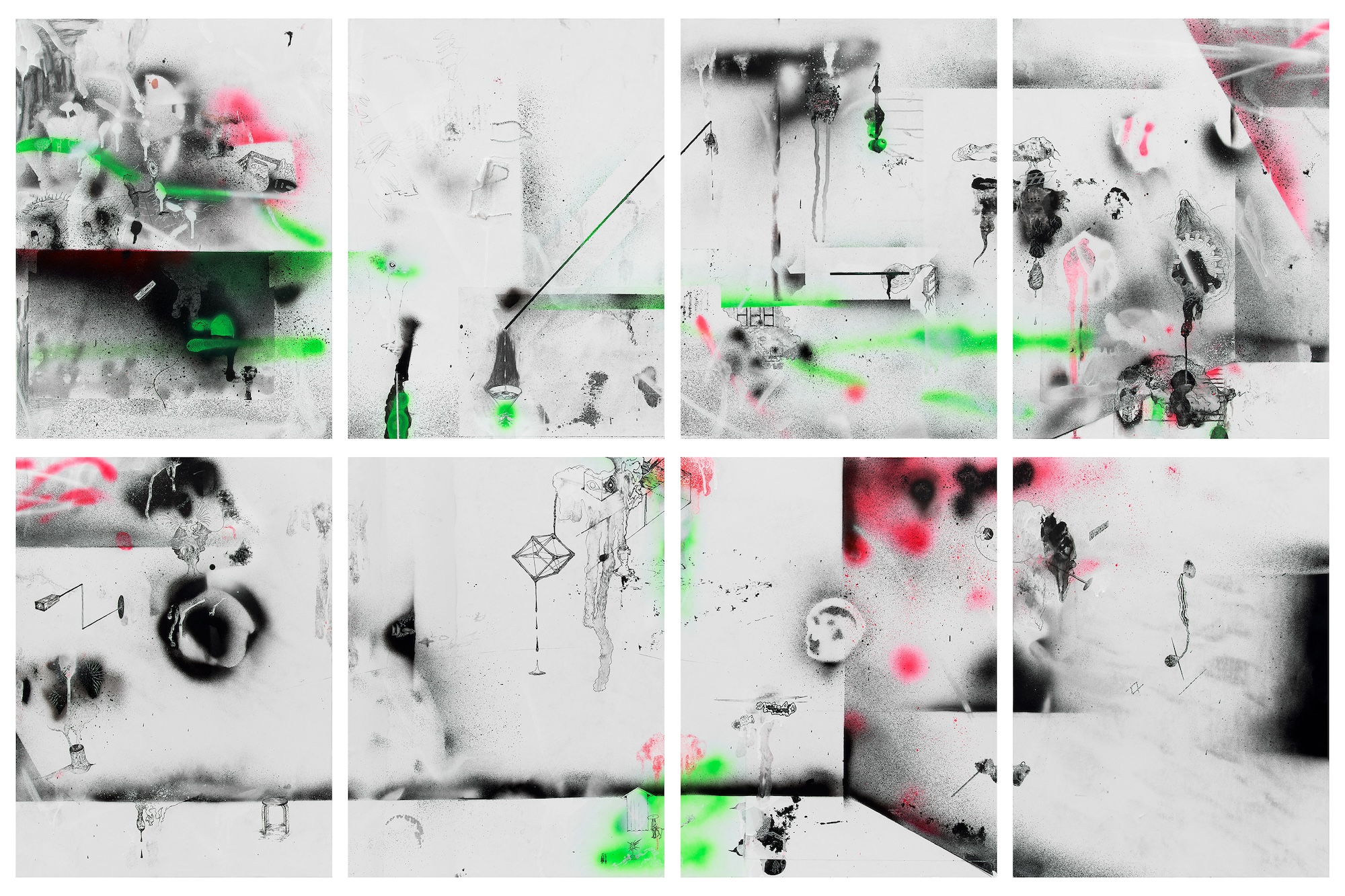
As the urban scene of Manhattan continuously weaves its narrative, the onsite drawing of Kosuke Kawahara emerges as both a reflection and disruption of the city's ceaseless rhythm. Herein lies a journal, a personal account of my encounters with Kawahara’s evolving onsite drawing making, where the city's metamorphosis and the artist's philosophy intertwine in a dance of color, form, and shadow.
February 6th
Encountering Kawahara’s work for the first time, I mistook his canvas for a monochromatic silence, only to discover it was a subtle symphony in color—his way of painting darkness with light. As I witnessed the artist transporting these papers with remnants of his art-making process from the studio to the gallery walls, Kawahara explained that the black traces were remnants of his creative process, each a historical whisper from the studio to the gallery. They accord perfectly with the palimpsest of postings, personal and commercial, that we city dwellers watch as they go up and are covered and taken down and then replaced over and again every night to be seen by day.

February 14th
The papers are now mounted on the gallery wall, and Kawahara has added hints of pink spray, reminiscent of the radiation he's described in the past—a signature touch, perhaps, rooted in his ethnic history. These vibrant edges defy the canvas's confines, embodying the free-spirited essence or perhaps the boundless soul's vessel in transit, impossible to outline. At the other end of canvas, the reattached fragments bear the marks of repair, a needlework of time stitching together what was once torn.
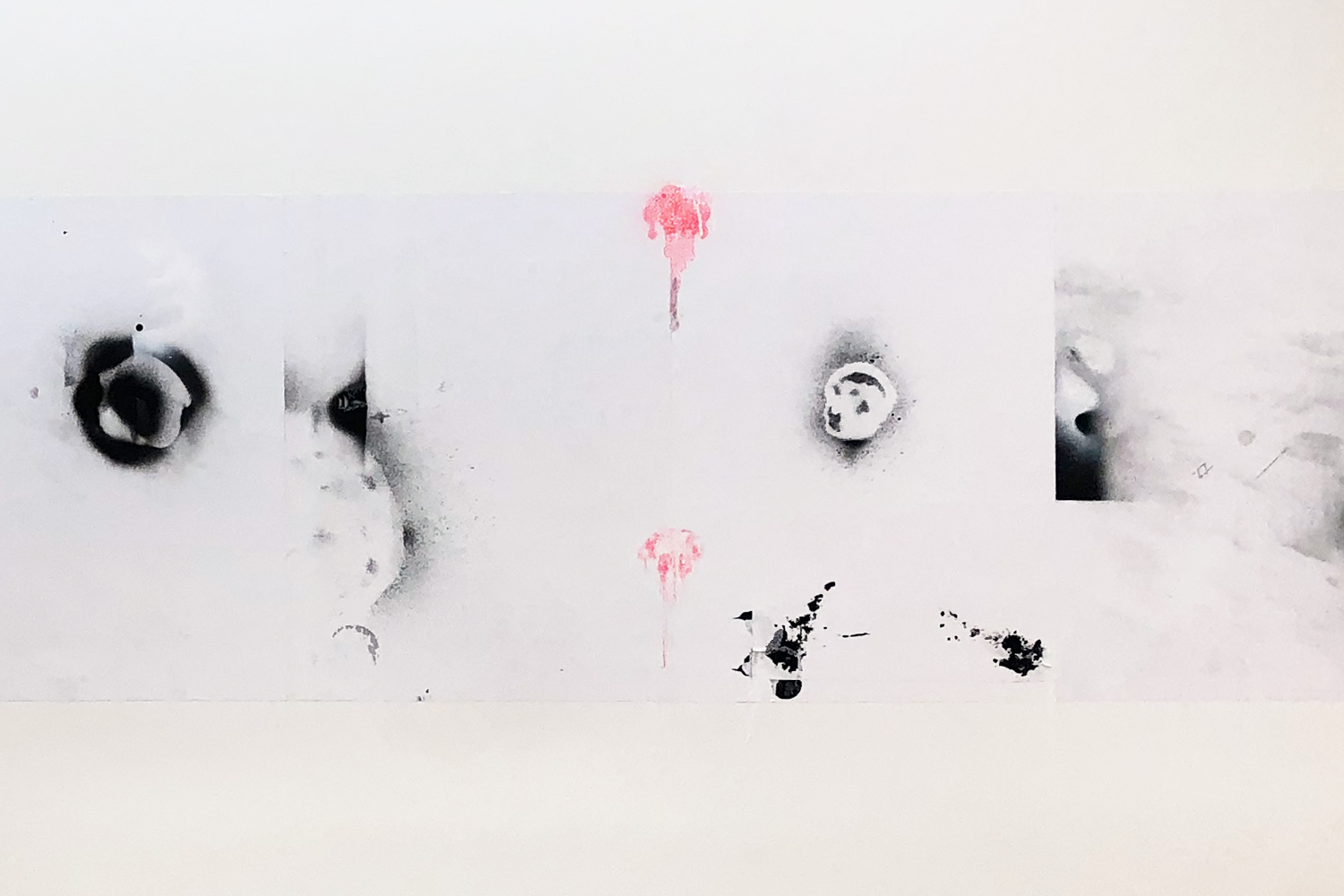

February 20th
Kawahara officially began the wild process of posting on the street. He layered his posters over those of others, sometimes covering models' bodies, sometimes obscuring their faces. The rustling of paper in the cold wind and the night's warm lights gave each poster an otherworldly glow. These installations, are far more than static displays. They are living entities that interact with the elements, evolve over time, and engage with New York's ever-changing scenes. They share a long history with the street art of the Lower East Side that became a vital part of the New York art scene.


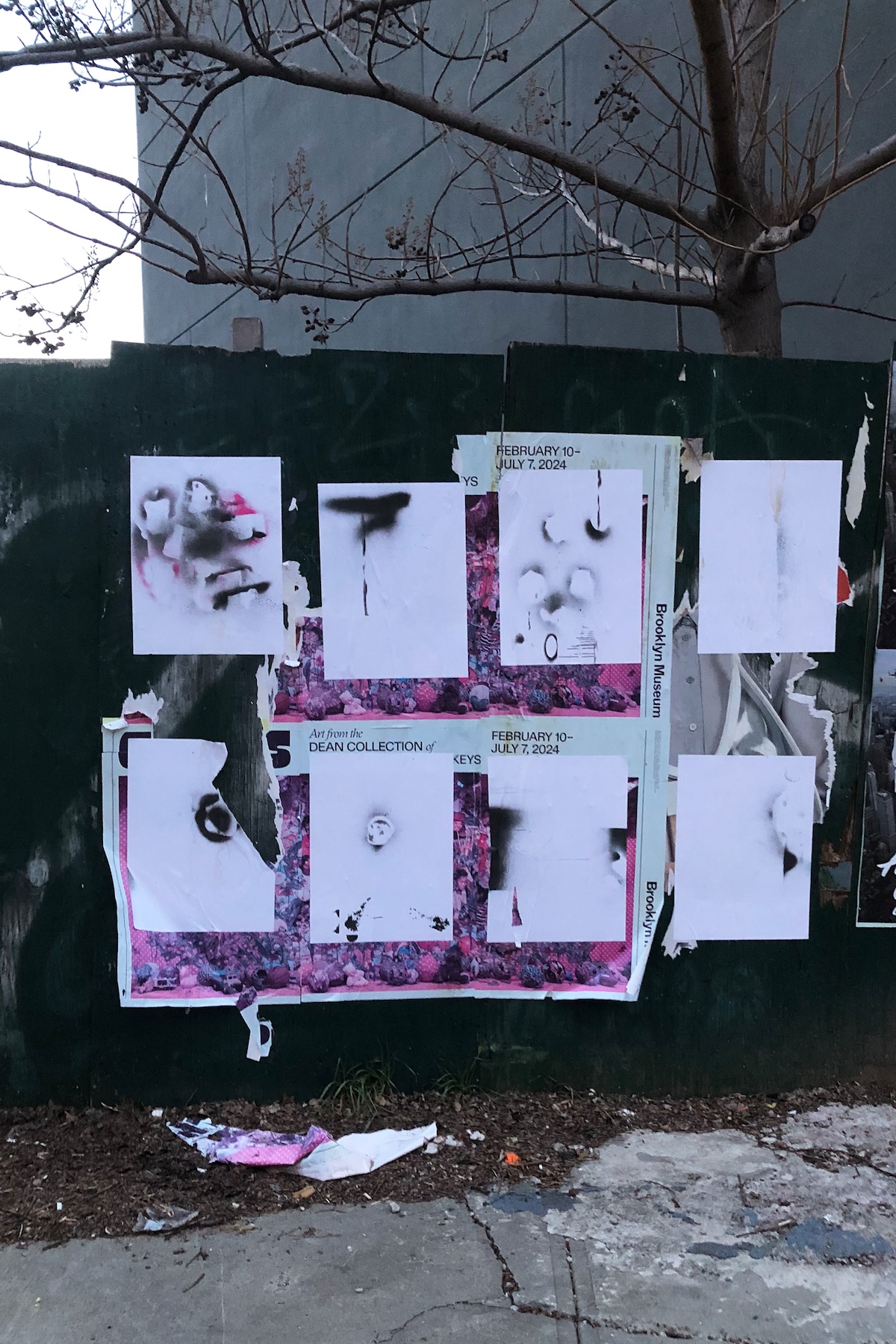
February 21st
Returning by day to where the wild postings had been the night before, we found no trace left—each had been eclipsed by a fresh layer of advertisements. In this city environment, this cycle of emergence and erasure feels akin to a natural rhythm of life itself. These installations are far from mere static displays; they are animate, intertwining with the elements, evolving with time, and engaging actively with the pulse of New York. It's here, in this space, where the ceaseless cycle of urban growth and decay is enacted in real-time. Today, the sunlight is glaring, almost blinding—a stark reminder that the realities we face can be just as unforgiving.
February 22nd
Today, the Exotic Star reception brings energy. As I stood amidst the crowd, the overlooked Mycostupa beckoned to me. The fungiform origins, reminiscent of the imprints on the distributed posters, are a silent dialogue between the artist's studio and the gallery space—between the mold of inspiration and the bloom of expression. Fungi bloom overnight, suddenly growing from the decay, signals that death is never absolute.
February 28th
It was then that Kawahara shared a secret pilgrimage into the heart of the city's bustle. In the past week, he cast 88 wild postings across Midtown and Brooklyn, his silent ode to the Shikoku 88 Temples Pilgrimage. The streets became his temple walk, each posting a prayer, and each location a shrine to the artistic journey that beats within New York's concrete veins. Back to the gallery I watched as Kawahara incorporated orchid blossoms into a poster, layering over the mushroom imprints. It's as if he used a single-point perspective on a 2D plane to craft a sense of depth, leading me through layers into another dimension. The essence of art fluctuates with the perception of its beholders, while the moment a visitor pointed about the orchid traces, pondering over Kawahara’s fascination with mushrooms and the recurrence of such fungal imagery. The concrete nature of what Kawahara renders remains elusive, and within this discrepancy of understanding that the significance of his works does not diminish, nor do they become any less fascinating. The orchid in the myriad blooms of his painting and posting, in a sacred circuit of creation and contemplation.

February 29th
In the morning, Kawahara brought a UV flashlight to reveal underlying secrets on the canvas previously hidden to the naked eye. As we drew the blinds, the space was filled with the glow of neon colors against the darkness. Vivid lines emerged, resembling vines, tree branches, or streaks of lightning in a storm, just like a revelation of another world. In the UV light, subtle details of white on white come alive, only visible in this altered luminosity. His onsite drawing became portals, like the Yokai of Japanese folklore, which connect the seen to the unseen. They beckon viewers to pause and reflect, to step into realms where mystical presences are just around the corner. It is as if I have never really seen the Yokai or deep-sea creatures he alludes to. The black light revealed a universe within the canvas, turning it into an astronomer’s dream. The neon colors were like stars in a galaxy, each line a comet's tail blazing across the night. They arrive in our retinas from a previous time, showing the continuum of past and present and hinting at a teeming future.
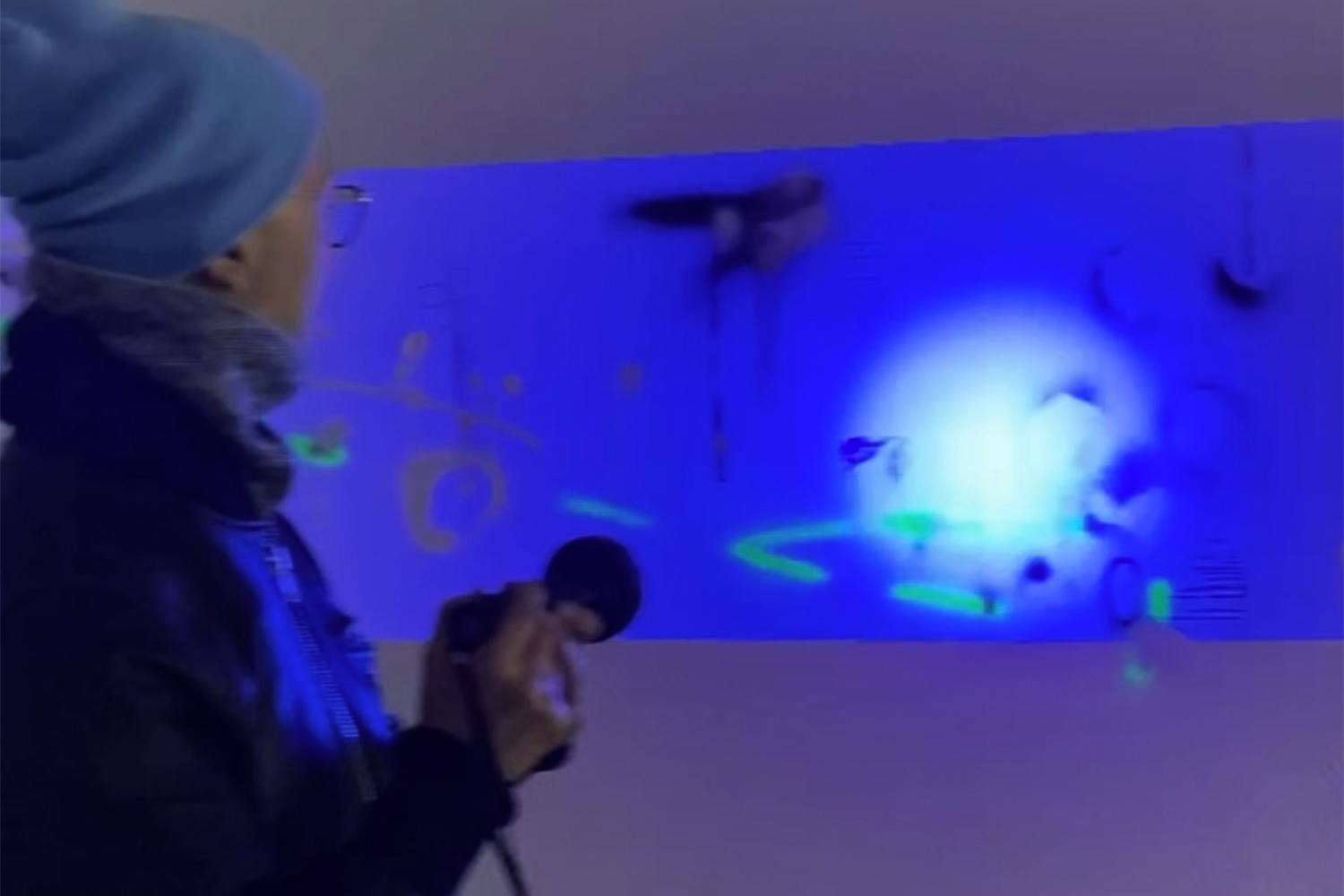
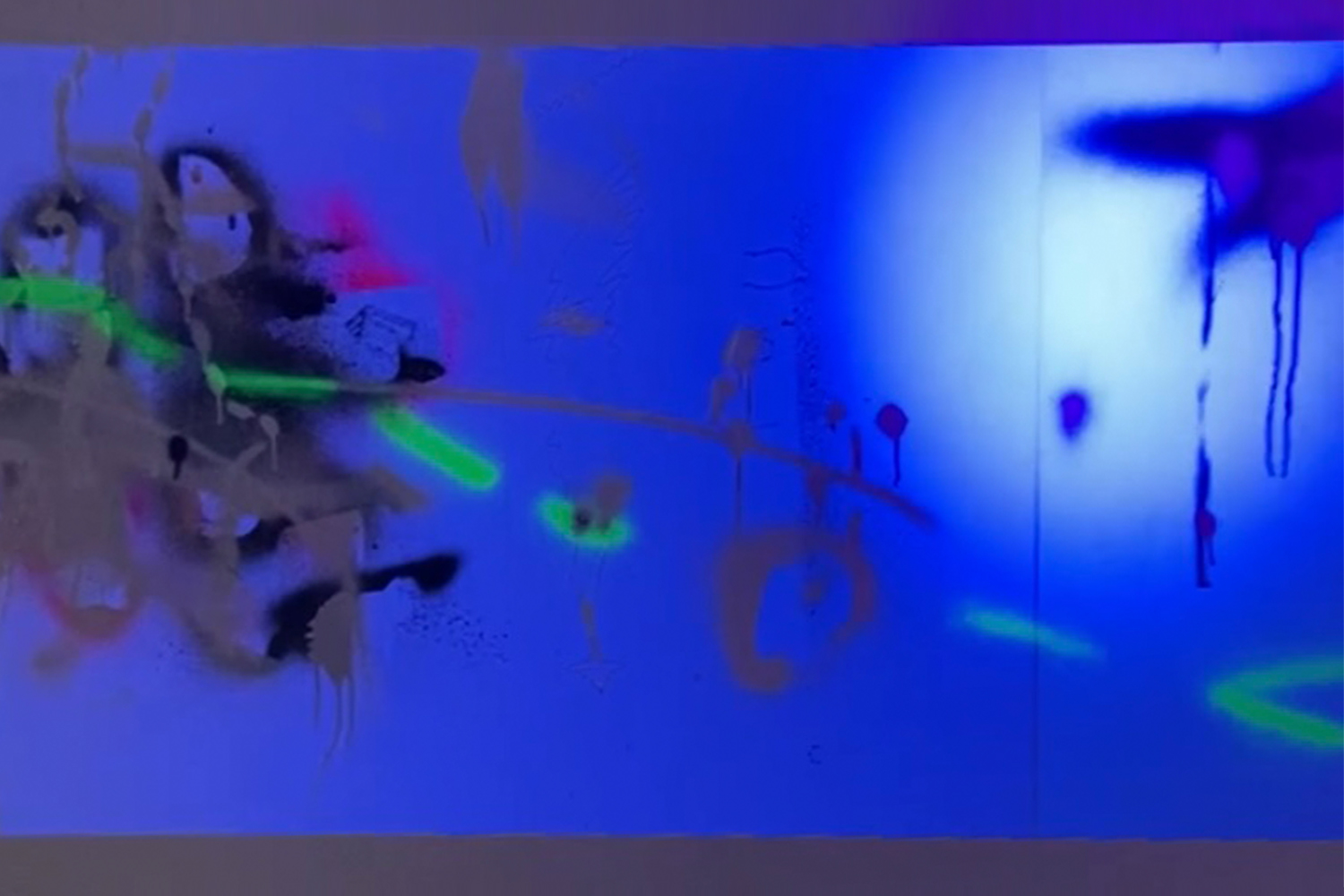
March 6th
As the drizzle of early spring caresses New York, I step into the gallery space, greeted by fresh strokes of neon green sprayed on the wall - whispers of spring seem to draw nearer. The persistent drizzle outside, tapping in harmony with my footsteps, draws me into a contemplative observation of Kawahara’s progress this week. Kawahara has layered a sheet of white paper upon the existing poster, which holds a miniature one-point perspective that pulls me into the scene of him crouching in contemplation at the gallery's corner, as he always says the process of making art is a meditation. This week, he enhanced the array of the white paint covering the original white and black elements. Tiny dots made by a marker pen narrate the journey of possibly non-existent creatures that once wandered this environment, leaving behind faint traces. Their footprints, mingled with rainwater, lead through the gallery's entrance, climbing the walls, as if scaling the canvas of our world.
March 13th
Today, Kawahara conjured another dimension upon the canvas, leaving a trail of thick, black spray that sketched out lines and constructed an open space facing the audience. Within this sculpted domain, numerous noticeable figurative elements emerge, reconnecting with the gallery space—a realistically painted gallery chair stands alone, as if allowing viewers to envision Kawahara sitting there weekly, immersed in his painting process. The shadows beneath the painted chair resemble those cast upon a puddle, yet in the grayish brushstrokes, I perceive the depth of the ocean. What dwells within its vastness? Creatures yet to be uncovered, or those considered grotesque simply because they remain unseen by human eyes? Surrounding it, the emerging figures seemed to be citizens of a world hidden within our own, each line a road on a map of a city built from dreams and shadows.
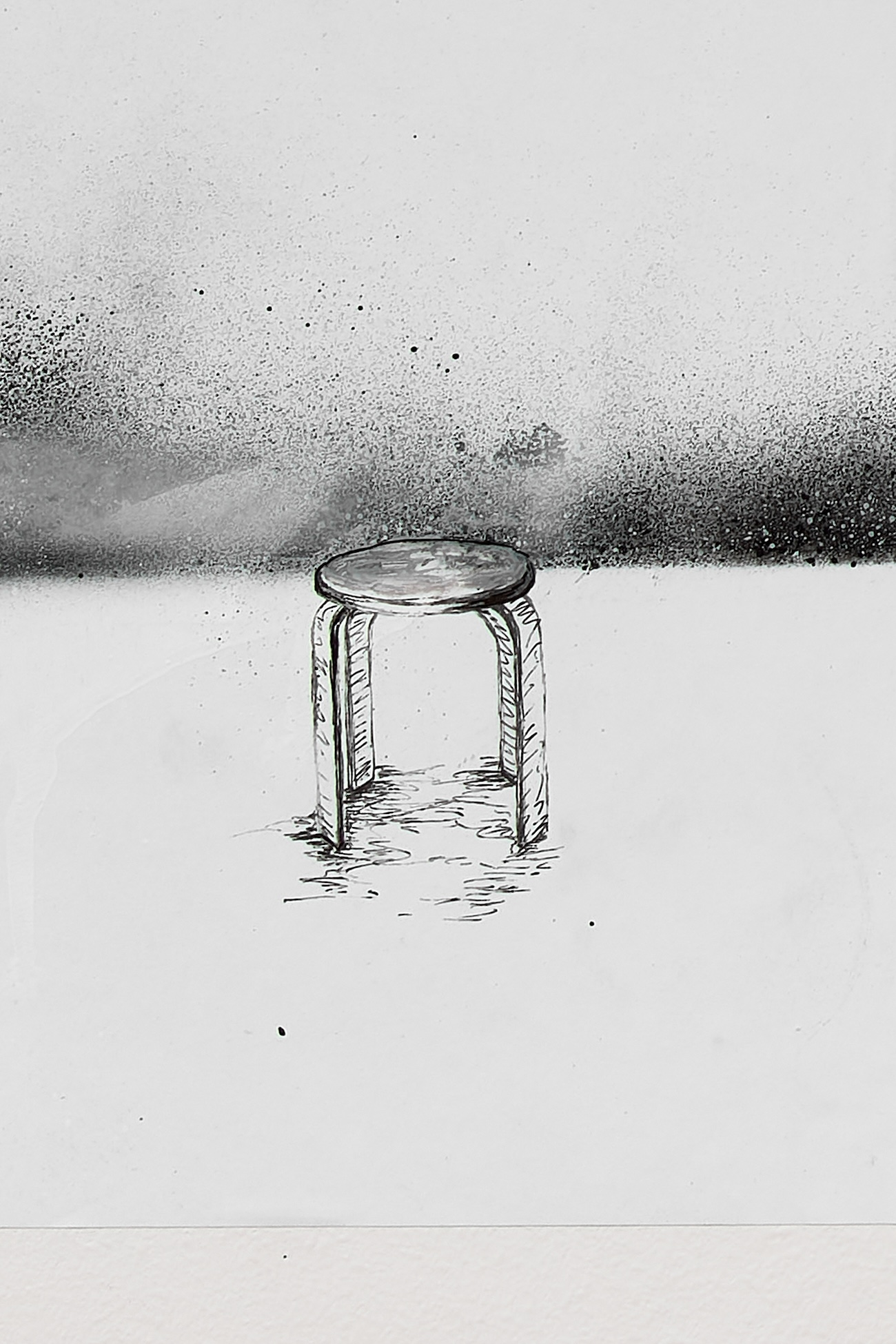
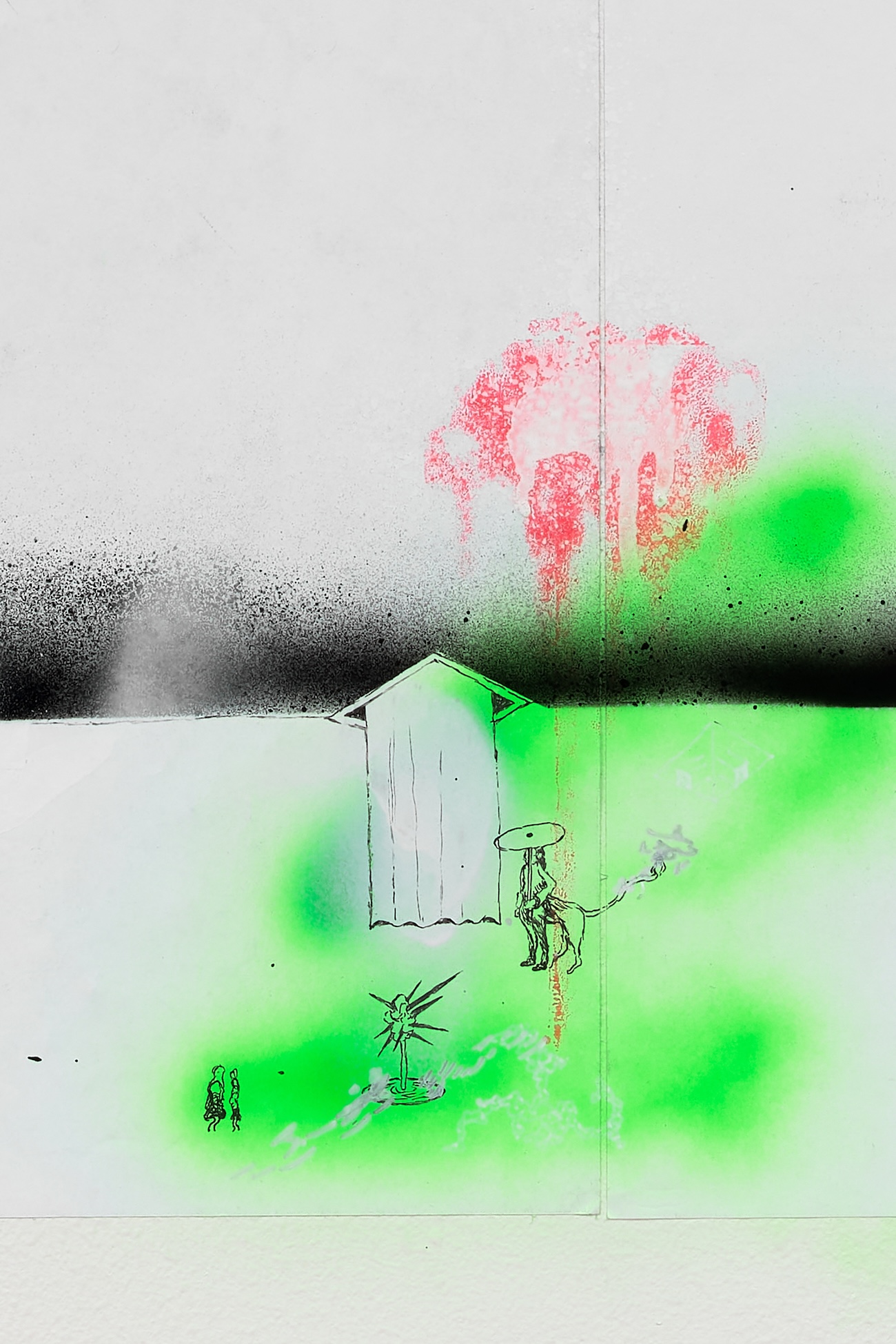
March 14th
Stepping into the gallery today, I finally had a chance to ask Kawahara about the figurative elements—what do they truly signify? He only offered a gentle smile in response, then showed me a photograph of his artwork in 2021, which portrayed a figure with devilish horns in the act of making mochi, except it was brains, rather than rice, being pounded. I guess all the movements of his drawn characters have inextricable connections to Butoh, a dance he once studied.
Curiosity led me to wondering about the evolution and plan of this work. Kawahara replied indifferently that the elements seen today might vanish, they are just growing as they are now, without a fixed idea; if he feels displeased, then covering them with paper remains always an option. He also mentioned last time he took a nap on the floor in front of the working piece before drawing anew. Indeed, the art-making process and progress are paramount—a lifetime process of discovery. His constancy is evident; he plans additional time on the 18th, 19th, and 20th of March to continue his creation at the gallery. I am awaiting the direction his journey will take next.
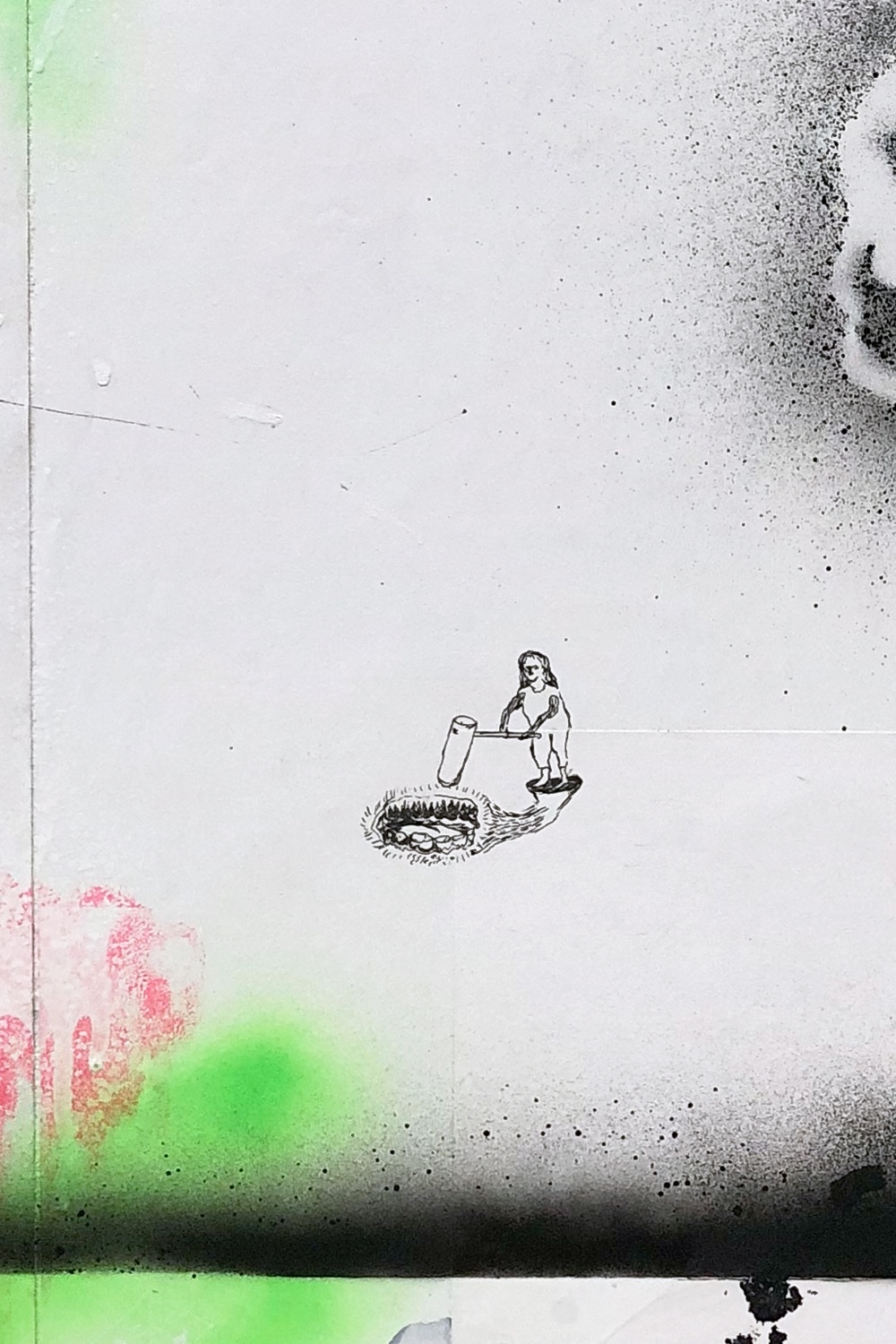

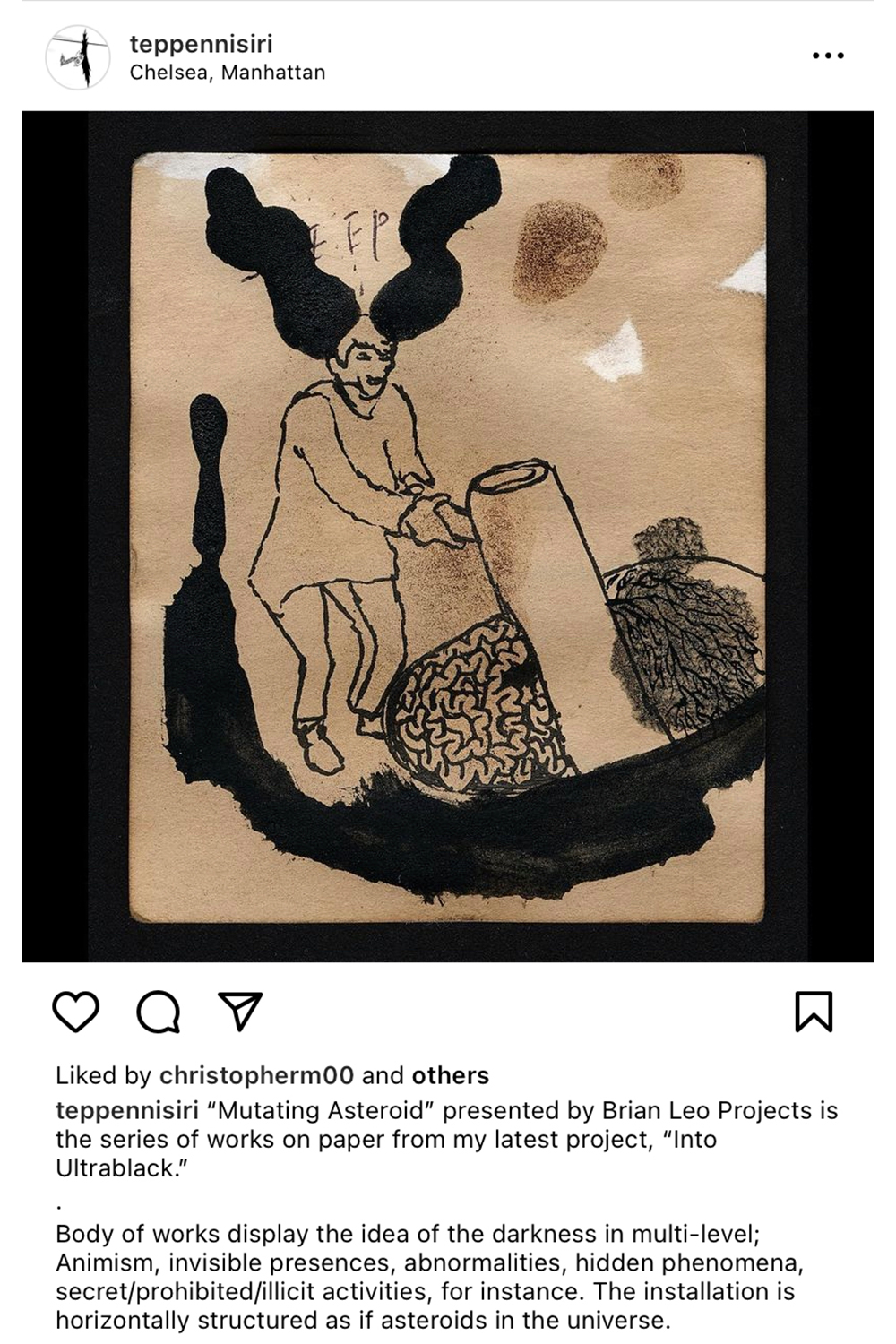
March 21st
One step closer to spring, a spray of pink adorns the top corner, heralding the cherry blossoms we all await. At the center, a stone shaped like the one in Ryoanji garden bears the texture of stone yet bristles with hairs and tendrils, reaching into an unknown domain. The black ink unfurled around it was a river at midnight, its currents deep with the ink of the cosmos, pulling me into a contemplative orbit. In this creative galaxy, I am but a traveler, looking for the familiar in the extraordinary, the mochi-maker who had disappeared, now obscured by the palimpsest of progress.
March 27th
Today, the art had morphed once more, a cubist heart beating in its center, tethered to reality by the geometric structures that danced around it. Within this space, I seem to discern Kawahara’s brushstrokes depicting the waves of ukiyo-e prints, perhaps even the braid of a fairytale princess or elements of a creature's fur, or like the steams rising from New York's manholes. These vaporous clouds, swayed by the gravity of this world, coalesce downward, forming faces of anguish that stretch far into the canvas, their expressions like a mirror to the city's own soul. The repetitive process simplifies and fades into smoke, venom accumulating drop by drop on each skull, exceeding the bounds of the canvas, dripping onto the gallery wall. It's a rainy day in the gallery.


March 28th
The canvas has become a symphony of lever-like elements, each one a verse in the epic Kawahara is composing. The long pole, a bridge between two disparate worlds, held the tension of a tightrope in the circus of existence, its one end ablaze with the fury of creation, the other end weeping ink from a solitary skull. I was drawn to the green spheroids, a garden of celestial olives, grapes, or perhaps eyes of a being not yet born. It's the cosmos, an illusion, and also the unseen lives of those around us. My gaze finally rests on the centerpiece, as I am sitting in the gallery, the sparks erupting from my typing laptop as if opening a portal within the space, gently rising into the air, connecting to another world amidst the swirling smoke. Our story pauses here, an open ending.

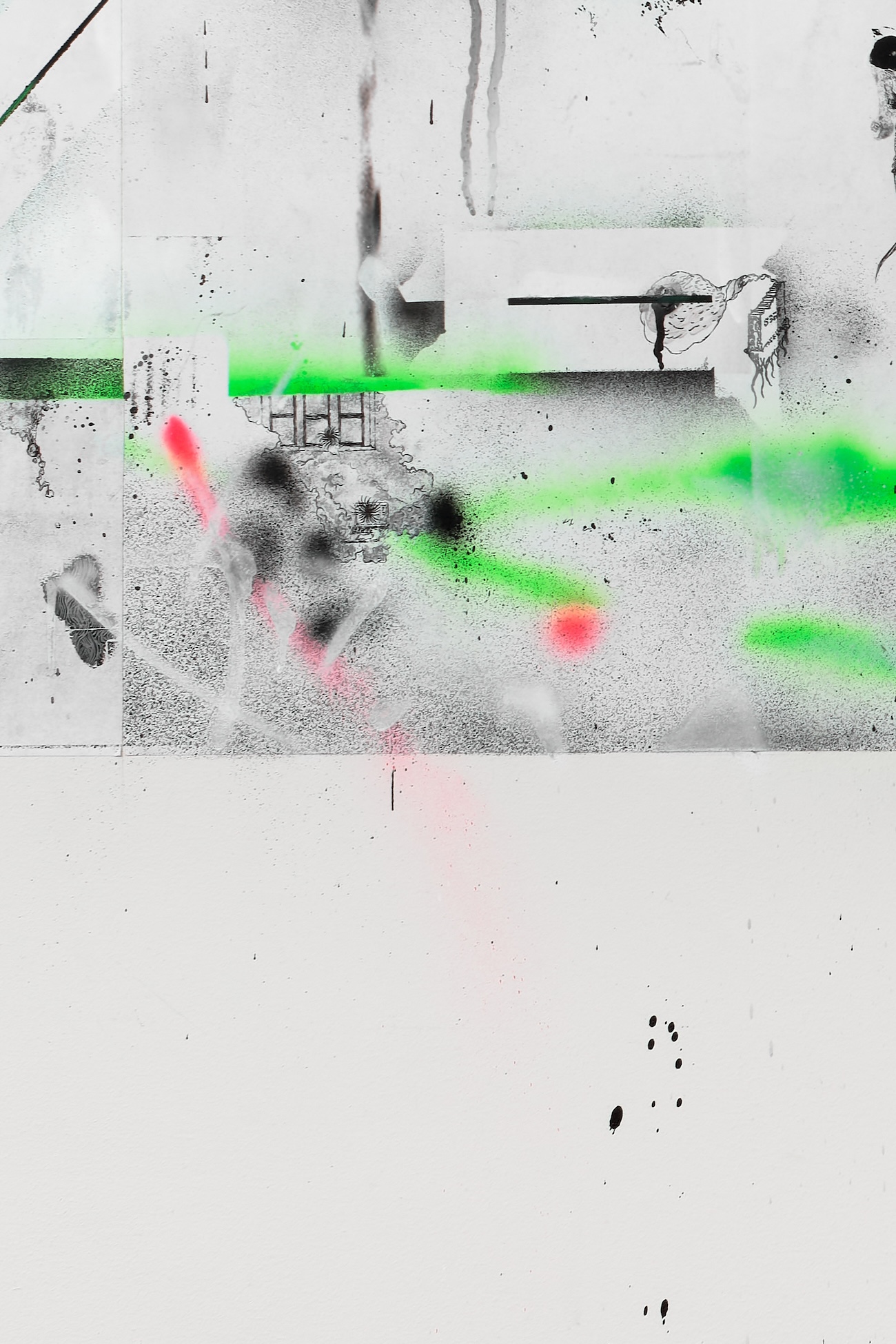
As I pen down these reflections, the set of drawings on paper stand not only as art but as living entities that breathe and adapt with the city's heartbeat. They capture the essence of Kosuke Kawahara's creative spirit—a spirit that thrives amidst the flux, that finds beauty in decay, and that continually challenges our perceptions of reality.
About the Artist
Kosuke Kawahara is born in 1980 in Kyoto, Japan, and moved to New York in 2011. Kawahara currently lives and works in Brooklyn. He earned a BFA in Design from Okayama Prefectural University, and graduated with an MFA in Painting and Drawing from Pratt Institute. His intuitive/impromptu gesture generates site-relevant imagery through its multi-layered structure. Kawahara’s works speak to notions of growth, decay, modes of communication and perception, spiritualism, interdependent relationships, and human behavior in ever-shifting environmental conditions. The whole process of creating a work from the start to its end is a process of the artist constantly exploring and (re)constructing the alternative space around darkness.
He has previously exhibited at The Elizabeth Foundation for the Arts (EFA), Trestle Gallery, Paradise Palace, Susan Eley Fine Art, and Super Dutchess Gallery. He has been awarded the Café Royal Cultural Foundation Visual Grant in 2022, the City Artist Corps Grants in 2021, and First Prize in Works on Paper by The Long Beach Island Foundation of the Arts & Sciences in 2021. He completed an artist residency at Lower Manhattan Cultural Council’s Governors Island Residency Initiative, and is currently a member artist at the EFA Studio Program.